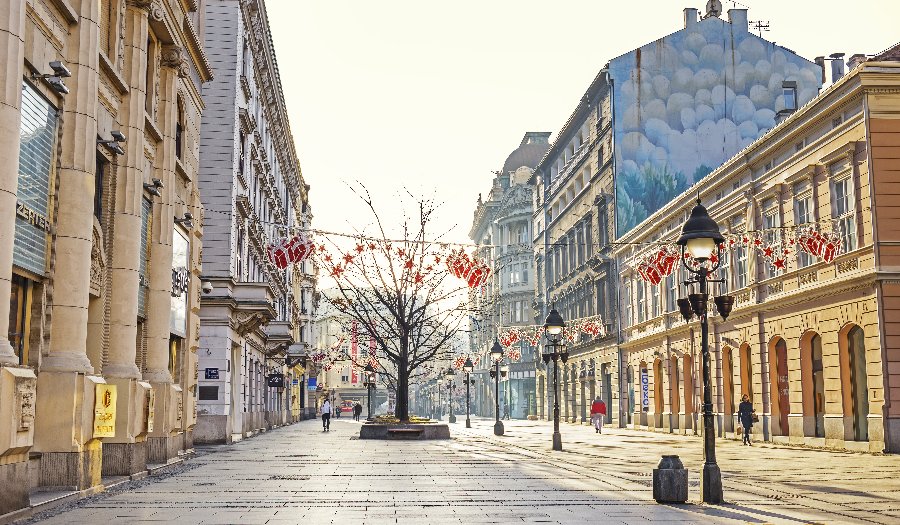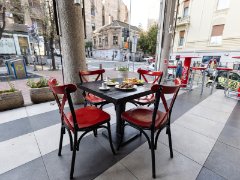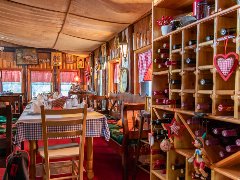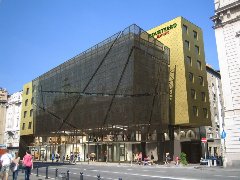Knez Mihailova Street is one of the oldest and most important streets in Belgrade, and also an evidence of a continuous existence of the city. The area of the street has traces of antique civilization.
One of the main Roman roads – Via Cardo – went along the present day street line. It cannot be confirmed that this area was inhabited in the Middle Ages. In the first half of the nineteenth century the old Roman aqueduct was repaired and the new water supply system was built. These were the essential conditions for the building of a settlement. During the Ottoman rule, the area of Knez Mihailova Street had five mosques. The most important were the Ibrahim–bej and Musala mosques. When the Austrians conquered Belgrade in 1717, they began to reconstruct the city and Knez Mihailova Street acquired a new appearance. The majority of the houses and mosques were pulled down and new houses were erected along the construction line of a regulated street which divided the town into the Serbian, western part and the German, eastern one. The same division remained after the Austrian army had left the city, only then the two parts were Serbian and Turkish. The revival of the city began with the final departure of the Ottomans in 1867, when Belgrade authorities accepted the western town – planning principles.
In the regulation plan from 1867, prepared by the first Serbian planner, engineer Emilijan Joksimovic, professor at the Lyceum and Belgrade College, Knez Mihailova was marked as the shortest connection between the Fortress and the town. The reconstructions done in 1867 and then in 1880 mark the abandonment of uncontrolled development of Belgrade and the transition to a higher level of urbanization. The present day situation shows that the street has kept its authentic size, profile and direction. Built almost simultaneously, the houses have uniform architectural forms. The materials used, the construction, function and style of the building in this street belong to the period when Belgrade architecture ceased to follow the principles of Balkan architecture and adopted European styles in building.
This process influenced the development of a bourgeois class and merchant ranks, who built their own houses and opened their shops in the new street. Although some of the houses on the street front have been altered or replaced in the twentieth century, Knez Mihailova has preserved the character of a representative commercial street. Towards the end of the twentieth century Knez Mihailova has evolved into a cultural centre of the capital.
Knez Mihailova Street is one of the oldest and most important streets in Belgrade, and also an evidence of a continuous existence of the city. The area of the street has traces of antique civilization.
One of the main Roman roads – Via Cardo – went along the present day street line. It cannot be confirmed that this area was inhabited in the Middle Ages. In the first half of the nineteenth century the old Roman aqueduct was repaired and the new water supply system was built. These were the essential conditions for the building of a settlement. During the Ottoman rule, the area of Knez Mihailova Street had five mosques. The most important were the Ibrahim–bej and Musala mosques. When the Austrians conquered Belgrade in 1717, they began to reconstruct the city and Knez Mihailova Street acquired a new appearance. The majority of the houses and mosques were pulled down and new houses were erected along the construction line of a regulated street which divided the town into the Serbian, western part and the German, eastern one. The same division remained after the Austrian army had left the city, only then the two parts were Serbian and Turkish. The revival of the city began with the final departure of the Ottomans in 1867, when Belgrade authorities accepted the western town – planning principles.
In the regulation plan from 1867, prepared by the first Serbian planner, engineer Emilijan Joksimovic, professor at the Lyceum and Belgrade College, Knez Mihailova was marked as the shortest connection between the Fortress and the town. The reconstructions done in 1867 and then in 1880 mark the abandonment of uncontrolled development of Belgrade and the transition to a higher level of urbanization. The present day situation shows that the street has kept its authentic size, profile and direction. Built almost simultaneously, the houses have uniform architectural forms. The materials used, the construction, function and style of the building in this street belong to the period when Belgrade architecture ceased to follow the principles of Balkan architecture and adopted European styles in building.
This process influenced the development of a bourgeois class and merchant ranks, who built their own houses and opened their shops in the new street. Although some of the houses on the street front have been altered or replaced in the twentieth century, Knez Mihailova has preserved the character of a representative commercial street. Towards the end of the twentieth century Knez Mihailova has evolved into a cultural centre of the capital.

























